Michael O'Keefe on Christopher Cairns
April 13, 2011
Artist Profiles Project
By Michael O'Keefe

Cairns, in studio 1985 ©Joan Fairman Kanes
Teacher is a title that I, as an artist, reserve for a handful of people. Of course, I learn lessons from many people, in some cases from idiots on the street or children at the park. And indeed I have learned enormous amounts of invaluable information from dead artists via their works. However, in spite of being an artist whose resume lists five different undergraduate and postgraduate educational institutions, I would tell you that I have only had a few teachers. Christopher Cairns is one of my teachers.
Between 2000 and 2002 I worked at Haverford College as the Departmental Assistant to the Art Department where Cairns, at the age of 60, was wrapping up a 35-year teaching career. Following this time at Haverford I lived in New York City for two years. During these two years I would often see Cairns, both in the city and at Haverford where I spent many weekends working in the foundry, helping to cast his sculptures. It is during this four-year period that I was deeply affected by Chris Cairns, his work, and my proximity to his world. And it is from the vantage point that I had during these four years that I will try and make a portrait of Chris Cairns, not as a teacher, but as an artist.
It is worth noting that during the four years I have mentioned, Cairns only visited my studio twice to give any formal critique of my work. Cairns believes in the development of the individual through working. Hard work was regularly noted as a virtue in Cairns’ classroom. In fact, he often made the point that hard work was a much more essential ingredient for artistic success than talent. I also believe that Cairns made few official visits to my studio because he was quite confident that I was receiving a strong dose of influence by simply being around him and all that that entailed.
I was often invited to have dinner with the Cairns family, where I got to examine the collection of art in the Cairns home. As good as the meals always were, the real thrill for me was discovering the works of art there, works that, underneath the distinctive elements, shared a kinship. In seeing the way Cairns lives, surrounded by these works of art, it was apparent that he does not see himself as a purely self-contained artist whose work has no precedence or influential context. In this modest home in Haverford, Pennsylvania one finds a few works by Cairns himself, but other artists made most of the works of art displayed there. On a number of occasions I sat in this home and heard stories of how these various artists fit into a puzzle of influence and commonality. These artists include: Peter Agostini, Francoise Andre, Alexis Cairns, Nicholas Cairns, Bruce Gagnier, Joseph Goto, Walter Hall, Fritz Janschka, Earl Kerkam, Marko Krsmanovic, Michael Lekakis, Mike Price, Scott Sherk, Jonathan Silver, Lance Solaroli, George Spaventa, Charles Stegeman and Kevin Tuttle. These are the artists that begin to give a context for the life and work of Christopher Cairns.
The context for Cairns’ sculpture is not limited to the 20th century. In fact, in various ways his work is in dialogue with much of the entire history of sculpture, excluding many of the fashions since the 1960’s. Cairns would often present slide shows of various works of art to his students. These were not formal presentations but rather impromptu commentary on works of art that he finds powerful. More often than not the content of these presentations would span huge periods of time and would skip across cultures and continents: An image of a Tilman Riemenschneider sculpture from the early 16th century would be followed by an image of an Ife sculpture from west Africa, then followed by a Giacometti sculpture from the early 20th century, all the while Cairns would be talking in ways that expressed much more concern for what these works shared rather than how they were different. This was a shocking contrast to a college professor of mine who told me the best thing I could do as a young artist would be to hunker down in the library and read every review in Art Journal starting with the year 1960. The prescription that Cairns would give to a young artist would be regular trips to the art museums, drawing from the drawings, paintings and sculptures housed there. On a bookshelf in Cairns’ home is a stack of drawing pads filled with drawings that show Cairns’ commitment to this practice. These are beautiful drawings that show a careful study of great works of art. These drawings also reveal a personal experience, a solitary sifting through the sea of great art.
In many of these same drawing pads one finds drawings made in front of a live model. Cairns based a lot of his teaching on the convention of working in clay or with drawing materials in front of a nude model. It was in the classroom of Peter Agostini at Columbia University during the academic year of 1965-66 that Cairns was first introduced to this way of working. Cairns has since continued to work in front of a model off and on, resulting in a deep understanding of human forms and how they relate, an understanding that underpins all of his work. Working from observation has rarely been an end in itself for Cairns. Instead it is a means to understand essential aspects of the language of sculpture, a means of becoming highly sensitive to proportion, balance, form, tension, etc. It is also a way to commune with his subject, the figure. Cairns has made a few sculptures that successfully render a rather straightforward figure through a process of observation, but most of his work is a departure from naturalistic or literalistic figuration.
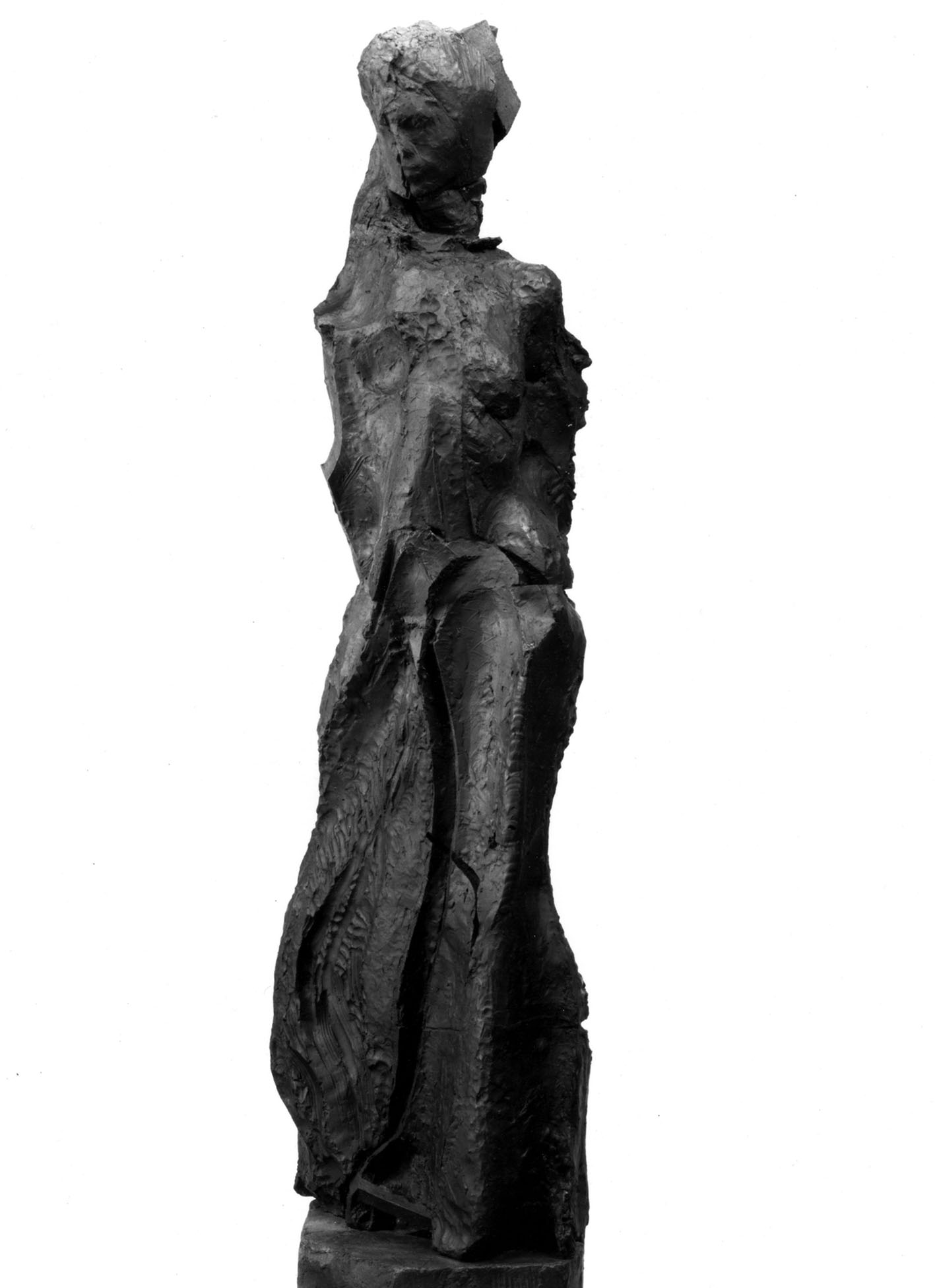
Black Madonna 1984, bronze, 6' high
The large figures that Cairns made in the 1980’s have a dynamic and beautifully realized combination of naturalistic, modeled forms and bare formal elements turned inside out. These female figures reveal Cairns’ interest in literature, history and religion. They are narrative, allegorical figures that embody aspects of the human condition, referring to ideas of sacrifice, suffering, love and death.
When talking about sculpture, even sculpture that is made from direct observation of a still, live model, Cairns will use words such as movement, velocity, compression, torque, extension and tension: Cairns’ sculpture relies heavily on gesture as an animating element. This is most apparent in the large figures from the late 90’s through 2004, such as the large group installations Wieviel Stucke and Recognition / Remembrance. The “body language” of these figures contributes to their narrative but the gesture of the figures also serves to create dynamic movement between the primary expressive parts, most often being the head and the hands (and in some cases the feet). A few times I heard Cairns attribute this idea of heads and hands to Medieval Sculpture, and for good reason, but it is an idea that one can see throughout the history of sculpture. It is an idea that is rooted in essential human interaction: we find meaning in body language, but we rely most on hands and heads for critical expression and communication.
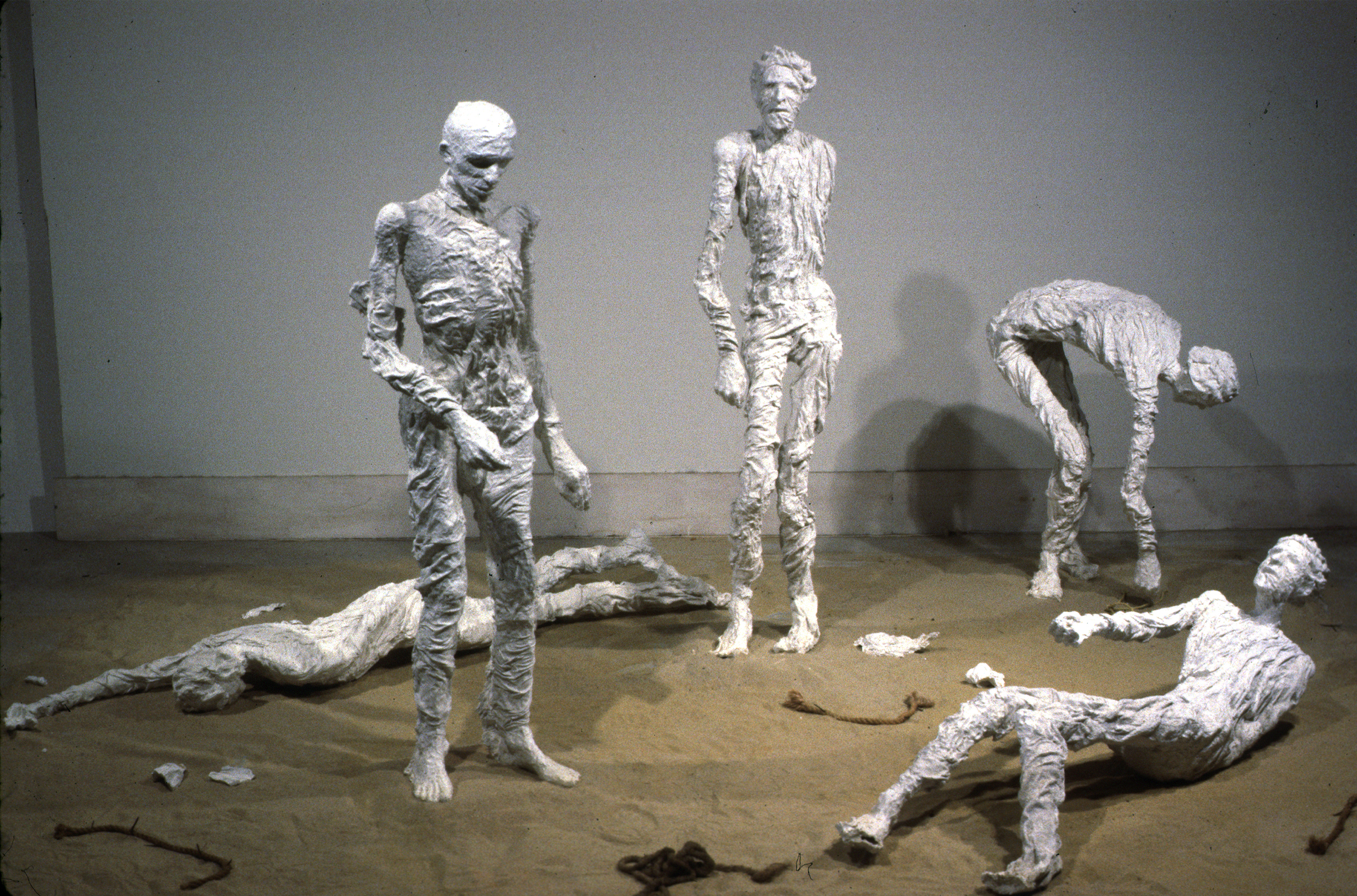
Wieviel stucke? 2000 plaster
The expression of Cairns’ work tends to be severe and grave. Consider Cairns’ Rack of Heads, a 12’ tall group of shelves that support about 35 different heads made over the span of fifteen years prior to 1996 when the piece was assembled. In this ensemble one can find heads that have a severe facial expression, that of agony or anguish, desperation or despair. But it is not simply the facial expressions that create the severity of the work. The overall scale of the piece is demanding; one is consumed when standing in front of this wall of sculptures. And when one approaches a single head they are not only confronted by the psychology of that sculpture but also by a lively surface. The urgency of Cairns’ expression is felt in every element of his sculpture, from the largest compositional element to the smallest evidence of how the work was touched by its maker.
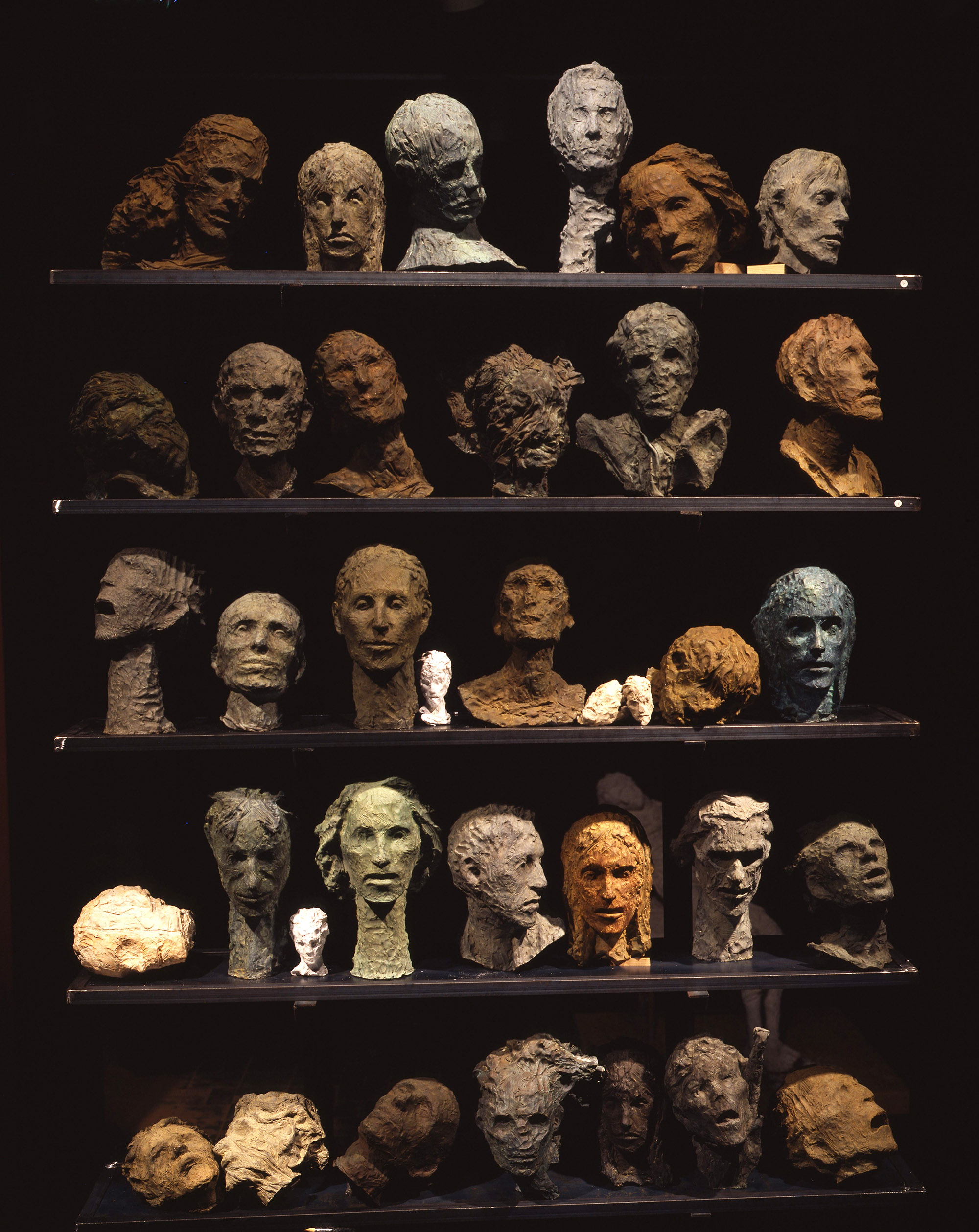
Rack of Heads, 1996, bronze
The initial and most profound impact of Cairns' sculpture has little to do with surfaces. However, when one examines any of the work closely one is consistently seduced by the rich and wonderful surfaces of the work. The surfaces themselves are gestural and stirring. These surfaces offer insight into a process of making that is impulsive and technical, improvisational and precise.
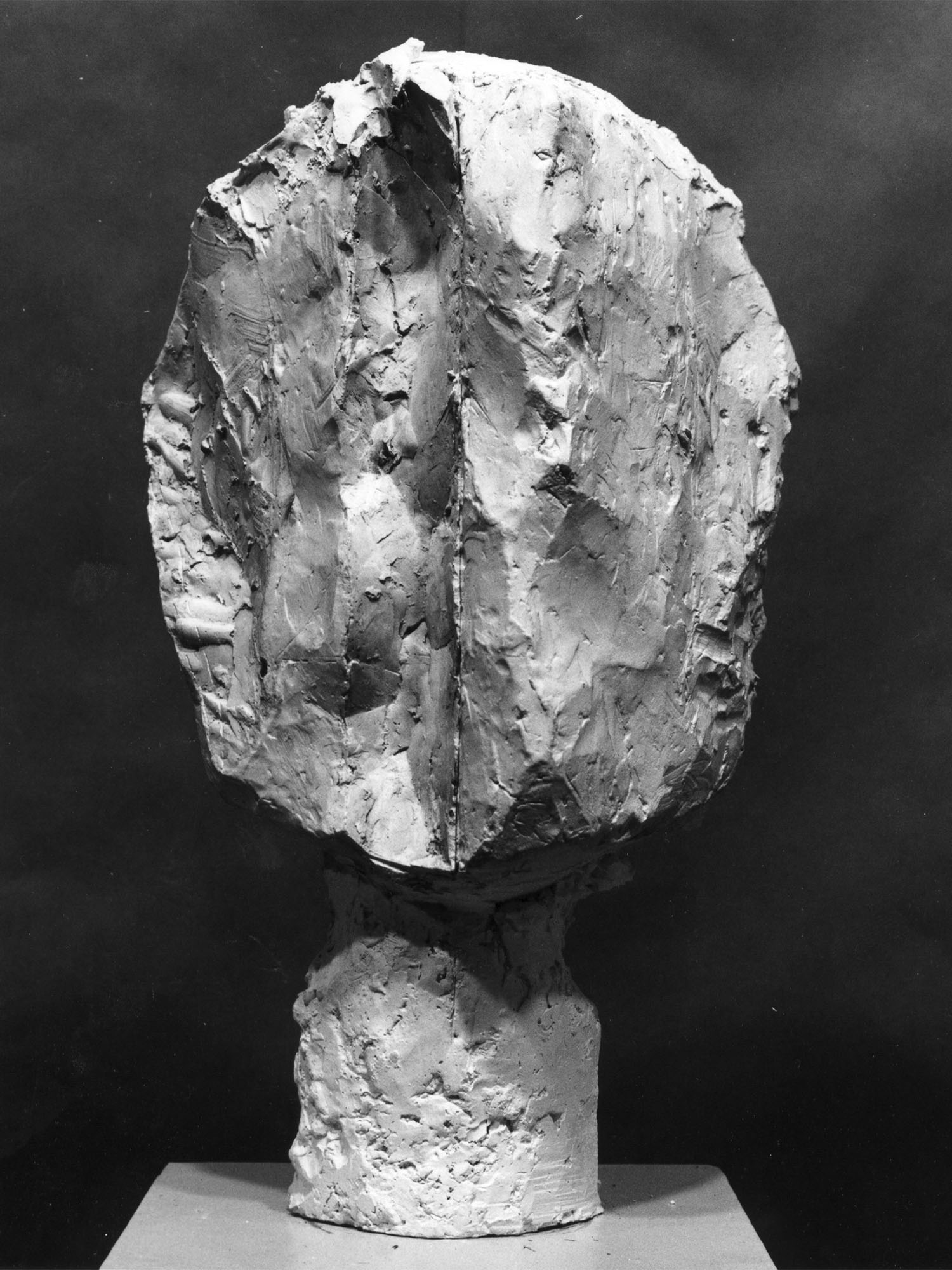
Last head, 1976 plaster 30"h
In the 1970’s Cairns emerged from the heyday of Minimalism making sculptures that reinvigorated the figure as a vital subject. While many artists were beginning to use the figure in a Duchampian way, Cairns was making sculptures that expressed a full spectrum of human psychology. These sculptures were not made to be part of the spectacle of contemporary art. It was during this time that Cairns was working in dialog with Jonathan Silver. The two artists developed a way of working that, in a very fresh way, picked up where artists such as Rodin, Rosso, Giacometti, Picasso and Braque left off. In the early 70’s Cairns and Silver were focused on composing within the modernist motif of the isolated head. These heads from the 70’s have the complexity of analytical cubism and the austerity of Egyptian reserve heads. It was in the mid to late 70’s that Cairns began to apply the same concerns to the full figure. This work from the 70’s was made with a construction mentality, working variably in plaster and clay. Many of the full figures exploited the total range of possibilities that plaster offers as a sculpture material, a material that Cairns was introduced to while working as an assistant to Peter Agostini. With these sculptures conventional mold-making techniques were used not for the sake of reproducing a finished work but as a means to deconstruct and reconstruct the sculpture throughout the making process. Partial casts, plaster shards and discarded mold pieces were joined together to make new compositions. This making process had built into it conditions that inevitably led to new possibilities. The figures and heads that Cairns made in the 1970’s are some of the most exciting sculptures made in the past 50 years. These works of art pursued traditional sculptural language and contemporary concerns to their edge, unfolding beyond that edge in striking revelation.
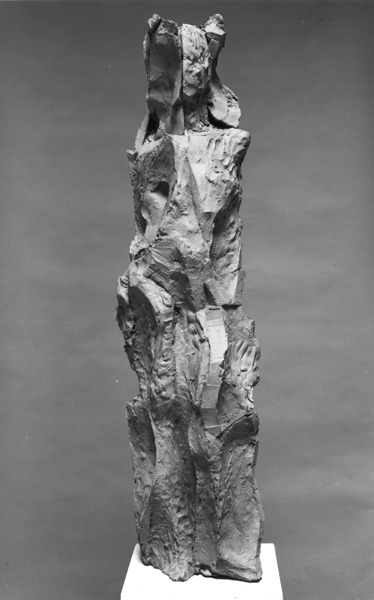
Powell figure,1976, 40"h
I had the valuable experience of watching Cairns plan, prepare and execute the installation of two large exhibits of his work, once at The Cantor Fitzgerald Gallery on the campus of Haverford College in 2004 and once at The Erickson Gallery in Philadelphia in 2001. In both cases, the entire group of work being shown, sometimes varying in scale and aesthetic concerns, was always thought of as a dramatic ensemble. Cairns understands the long-established power of sculpture when placed strategically within an architectural space, considering the narrative of how people approach that space, enter and move through it. The most intense presentation of Cairns’ sculpture can be found at his studio in Havertown, Pennsylvania, a 9,000 square foot former fire station that houses hundreds of sculptures and works in progress. This space displays many of the individual sculptures Cairns has made over the years, but more than that it displays Cairns deep love of sculpture and his unyielding and committed pursuit of a very distinct experience.
An old student and long-time friend of Cairns, Walter Hall, said it well when he wrote of Cairns, “I saw him (and still do) as an indefatigable, relentless spirit, unwavering in its conviction, driven to ends not defined by trends or fame or the marketplace, principled and uncompromising in the extreme.”
---
Michael O'Keefe is an artist living and working in Dallas, Texas. His work has been shown extensively in Dallas, where he is currently represented by the Valley House Gallery, as well as in New York City and Pennsylvania. O'Keefe teaches drawing and sculpture at various colleges as well as non-academic institutes in the Dallas area. Learn more at www.michaelokeefestudio.com.